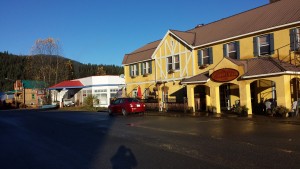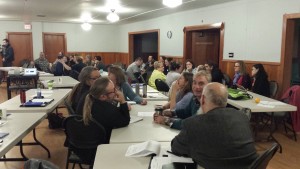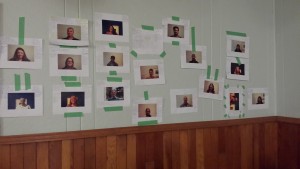On Monday March 13, CAPACOA and Strategic Moves will facilitate an interactive web conversation on Digital Innovation in Performing Arts Presentation. Everyone is welcome to participate (10 am Pacific/1 pm Eastern).
Tag Archives: Written by Inga Petri
The spaces in-between the places: On frequent travel
In my current version of life as a speaker and consultant I am thrilled to get invited to work across Canada. Then last year, I decided to actually live in two places about 5,000 km apart (Whitehorse, Yukon and Ottawa, Ontario). Already in my sixth year as a frequent traveler, I have had to find ways to not feel disconnected or plain lonely. It feels like I have finally found some groove in the last couple of years that keeps me socially connected and engaged with wherever I am.
Today a touring musician friend posted this update on Facebook:
Things that make me really happy:
Great Luggage.
New movies on Air Canada.
Great conversations with taxi drivers.
Swedish meatballs as snacks.
That post reminded me about the spaces in between the places I go. As my travel schedule has grown I’ve come to focus a lot more on all the life that can happen in those spaces: like that hilarious late night conversation on the plane to Whitehorse the other day with one of the House of Commons staffers travelling with the Parliamentary Committee on Electoral Reform. Or that messenger chat with a distressed friend while waiting at the gate. Or talking to the mom with the kid that is having a terrible flight and not making her feel bad about her child being a child. Or drifting off on that after lunch nap on an Air North flight to YXY – while in my regular seat (yes, I always get the same seat when I check in on AN) – and listening to my favourite artist on my iPod. Or binge watching new movies on Air Canada flights. Some of my friends may be surprised that I rarely work while in transit … to me offices and conferences are for working. I’ve come to prefer to be in transit and see what life there holds in store.
Of course, my friend managed expressed all that in the songpoet’s way in 4 half-lines!
New study on the arts in rural communities examines three regions in Canada
“The specific characteristics of the performing arts eco-system matter to whether they can fuel vibrant rural communities.” With this hypothesis in mind, I have been investigating whether there are common criteria or success indicators for building a sustainable, rural arts community. This exploratory research draws on existing literature about arts in rural communities as well as my work with organizations in rural communities from coast to coast to coast. In this initial phase of the study I focus on three communities: Haliburton County, Ontario; Temiskaming Shores, Ontario; and Wells, BC.
I will present findings from this new study for the first time at the SPARC Symposium taking place in Haliburton from October 27 to 30, 2016.
My work with SPARC goes back to 2014: I presented a keynote at the first SPARC Symposium in April 2014 on “Co-creating a Culture of Place in Rural Communities.” Then SPARC invited me to co-facilitate the SPARC Network Summit in November 2014. In my ongoing consulting practice I also work with small, rural and remote communities to help strengthen local capacities and capabilities.
A key goal of the SPARC 2016 Symposium (a project of the SPARC Network) is to create an environment where people can network: exchange ideas, find opportunities for collaboration, discuss solutions to tricky problems and identify big ideas. Attendees will have an opportunity to meet people engaged in the performing arts from rural communities throughout the province and across the country.
Whether your goals are professional development, learning strategies to attract new audiences, innovative approaches to sustainability, opportunities for information exchange, or developing creative methods for marketing campaigns or mentoring programs, it is SPARC’s belief that this year’s program will facilitate them: http://www.sparcperformingarts.com/sparc-symposium-2016/
See you in Haliburton next month!
Art is fuel: Community engagement in the CRD
The Capital Regional District (CRD) Arts Service is poised to begin a broad-based community engagement and consultation process to identify key implementation strategies designed to achieve the goals of the CRD 2015-18 Strategic Arts Plan.
I am thrilled that the CRD Arts Service has hired Strategic Moves and my project team to undertake this work. I am excited to get to know the communities and people of southern Vancouver Island better.
With the contract signed last week, we are putting everything in place for a round of pre-consultation sessions. On June 23 and 24, we will undertake a series of four sessions with as wide a range of people active in the local arts community and those interested in developing the arts in the CRD as are available. I know it is going to be short notice for some, but it is better than a July or August date when vacation season creates only more challenges. We will use this pre-consultation to introduce the project, our team and to gather initial feedback and input on the community engagement and consultation process itself. In my view, our job is to listen closely to the community as we build together a strong, meaningful and relevant implementation plan.
These pre-consultation sessions represent the beginning of a 6 months long process where those interested in the arts in the CRD will have several opportunities to make their voices heard and their ideas count about their priorities for key implementation activities the CRD should consider adopting over the next 3 years. We’ll reach out and invite the full diversity of artists and arts organization and communities throughout this process.
These last few days my working hours have been consumed with briefings, document reviews, planning more briefings with the Arts Committee of the Arts Service and the newly formed project Steering Committee, and planning these pre-consultation sessions.
As with all large projects with many different stakeholders, I expect deep conversations, vigorous discussions and healthy debate. It is the best way we have to ensure that the results of this process are solid and meaningful to the local arts community and the CRD communities at large.
In a word, as art is fuel, I am stoked.
Inspiration reverberates
Check out Emma Jarrett’s latest blog post on Sustainable Connection inspired by the Northern Exposure conference last month in Wells, BC.
I enjoyed working with her and we had some great conversations about authentic presenting. Her performance coaching practice applies to anyone who gets to work with a microphone, not only musicians.
Taking steps to understand digital potential in the performing arts
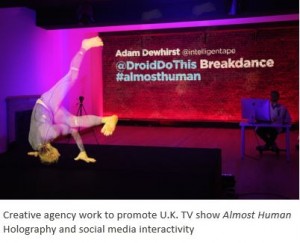 At the CAPACOA conference in Halifax this past January, attendee feedback suggested that I made a compelling case for Breaking the Fifth Wall: Digitizing the Performing Arts. Indeed, attendees were buzzing with the challenges and opportunities presented. Others who have watched the presentation online have asked me how they can get involved. You can watch my talk here on video. In it, I weave together a case for sector-leadership and sector-ownership in developing a future digital platform. I am most excited about digitization beyond the 2-D screens we have today. In particular, I believe a future-oriented perspective requires us to contemplate live-streaming/streaming 3-D renderings; holographic and or virtual reality convergence in technologies. Things most of us have never seen but enabling technology solutions are advancing rapidly.
At the CAPACOA conference in Halifax this past January, attendee feedback suggested that I made a compelling case for Breaking the Fifth Wall: Digitizing the Performing Arts. Indeed, attendees were buzzing with the challenges and opportunities presented. Others who have watched the presentation online have asked me how they can get involved. You can watch my talk here on video. In it, I weave together a case for sector-leadership and sector-ownership in developing a future digital platform. I am most excited about digitization beyond the 2-D screens we have today. In particular, I believe a future-oriented perspective requires us to contemplate live-streaming/streaming 3-D renderings; holographic and or virtual reality convergence in technologies. Things most of us have never seen but enabling technology solutions are advancing rapidly.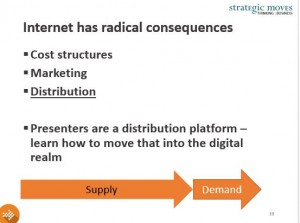
In this talk I offered a brief context of digital transformation in the last 20 years, an overview of experiments in digital performing arts presentation from around the world, a perspective on what it take to transform the challenging economic model that persists in live performing arts for the presenting field in particular, and a call to action.
At the upcoming CAPACOA national conference in Ottawa from November 25 to 28 I hope to turn that buzz into tangible action: Together with CAPACOA, we invite you talk about the next steps we as a sector want to take to drive this discussion forward and explore opportunities of digital distribution at scale in Canada and beyond. Can we establish a working group to spearhead conversations and build sector leadership on this central issue? Who wants to be and needs to get involved?
I am looking forward to facilitating this conversation on November 26 at 8 am.
Building community together: Northern Exposure arts conference
I spent Thanksgiving in the Cariboo town of Wells, BC (population 259) at the Northern Exposure conference.
Here are my reflections on what we did, how we did it and what it enabled; in so doing I hope to draw the curtain back a little on effective design thinking-inspired meetings that help people move to the next level – whatever that is for them.
Putting the team together
Island Mountain Arts‘ ambitious conference attracted about 75 festival organizers, arts organization staff and volunteers and musicians from BC’s northern and southern interior, the Sunshine Coast, Vancouver Island, Haida Gwaii, and the Yukon.
Island Mountain Arts (IMA – named after a local mountain, called Island) has been operating its renowned Summer School of Art since 1977 and over the years has expanded with a Public Art Gallery and Gift Shop, an International Harp School, the Toni Onley Artists’ Project and the award winning ArtsWells Festival of All Things Art.
Julie Fowler, Executive Director of IMA, invited me to facilitate this conference, based on my previous work with SPARC – Supporting Performing Arts in Rural Communities and the Yukon Arts Presenters Summit. And she recruited co-presenters and panelists from across B.C. to ensure a wide range of perspectives.
A common purpose: creating community
Speaking with Julie, we quickly established a common purpose: to build up a better networked rural festival and arts community.
My approach as facilitator and presenter was focused on creating spaces for participants to get to know each other, share knowledge and know-how, and encourage collaborative learning and action planning. Julie and her wonderful team took care of conference logistics, meals and showcases – 16 in total – at the local Sunset Theatre and the Wells Hotel. She arranged two sessions tailored for musicians.
The conference also had its share of great food by chef Sharon and the kitchen crew and a fine assortment of beverages at showcase and reception venues. Being in a small place, the conference moved as a whole from breakfast at the Wells Hotel to the Wells Community Hall for conference sessions, back up the street for lunch and showcases and then back for more learning. We shared dinner and conversations and then went off to the Sunset Theatre for showcases. A late evening snack invariably appeared at the Pub to maintain the stamina of musicians and participants alike.
I feel that having participants move together in this way, sharing meals and conversations in ever changing configurations, made for closer connections and more meaningful, relevant learning.
Pre-conference professional development
The pre-conference professional development day on audience development was attended by most of the conference participants. I delivered a well-honed workshop; modified as usual to suit the rural context. This session was highly interactive, with lots of conversation by all participants and practical learning. This was followed by a full slate of 15-minute 1-on-1 sessions with me. The nine participants brought a wide range of marketing and organizational questions to these intensive conversations.
At the same time, Emma Jarrett, a performance coach, conducted a fantastic hands-on workshop for musicians and anyone else interested in honing their presentation skills.
Creating an open learning environment
I borrowed a networking exercise from the Yukon Arts Presenters Summit (Let’s Get Connected) which in turn the Yukon organizers had modified from SPARC. The four topics were:
• who you are and what you do
• your hopes and dreams
• what you’re seeking
• what you have to offer
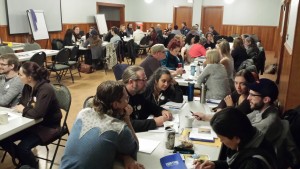
During the Let’s Get Connected process, participants had four 10-minute segments for reflection and conversation at tables of 6 each. A quick way to meet 20+ participants in an hour.
All participants had their picture taken at registration. They recorded the information on their print outs and then discussed it with their group. Every 10 minutes a room full of participants stood up and found a new table of six to move to the next topic. It’s an amazing free-flowing choreography.
With the sheets we created a Living Wall that served as a reminder of the breadth and depth of knowledge and experience each and every participant brought to this conference.
It was a powerful beginning that I feel set the tone for a true working conference: Participants heard their own voices from the start; felt valued as experienced organizers; and they became collaborators in co-creating our conference.
After a short coffee jaunt up to the hotel, I gave a well-received keynote on Co-creating a Culture of Place, in which I made the case, as I have at other conferences, for Vibrant communities fueled by the arts and its community-engaged partnerships. Much of the data in that keynote comes from The Value of Presenting study. This study continues to deepen the conversations about arts presenters and their role and impact in their communities.
After lunch, I had the pleasure of working with Janet Rogers – a Mohawk/Tuscarora writer and broadcaster from the Six Nations in southern Ontario, who was born in Vancouver and has been living on the traditional lands of the Coast Salish people (Victoria, BC) since 1994 – to share information and lead a conversation on Cultural Tourism. I provided context and laid out a cultural tourism landscape. Janet led a conversation on how to access indigenous artists for festivals and events, and encouraged making the necessary contacts early in the event planning process. She proposed that in so doing we could move from the acknowledgement of traditional lands into meaningful inclusion and full participation by indigenous and non-indigenous artists. After all, Aboriginal tourism is seen as a key aspect of expanding Canada’s and BC’s cultural tourism potential.
I felt this was an important and open conversation about an area many of us want to get right but also feel some insecurity about. These protocols are new to most event organizers. What excites me is that meaningful change can happen through our individual decisions and actions, by getting to know each other and speaking openly and respectfully to each other. We don’t have to wait until everything is figured out in the big picture.
Concurrently, Music BC presented a session for musicians on all of the sources of revenue available to them for their work.
I moved the programmed afternoon networking round tables outside to a walking conversation – thankfully the rain held off and the winds had died down.
Sharing stories and action planning
On the last day of the conference we were in Barkerville.
The morning featured five inspiring stories presented by Julie Fowler, ArtsWells Festival/Island Mountain Arts; Carla Stephenson, Tiny Lights Festival; Karen Jeffery, Sunset Theatre; Deb Beaton Smith, Rifflandia; and Miriam Schilling, Xatśūll Heritage Village, Soda Creek.
The panelists – participants conversation drew the curtain back a little on how to build success, how to sustain arts in small communities and the kind of perseverance, experimentation and serendipity it takes. Everyone was eager to share their experiences and it felt like the perfect transition to move toward action planning.
But first I led a practical workshop on integrated online marketing with Fraser Hayes‘ able assistance. Fraser is the station manager of CFUR Radio in Prince George; a community radio station that has built a substantial integrated online footprint to complement its broadcasts. More insights and specific action items tumbled forth and then we were ready for lunch, a walk about this amazing restored gold rush town and the final two showcases.
The conference concluded with action planning. First I asked everyone to write down key take-aways from the conference, their next action steps and desired short and long-term results. The process requires participants to write the information out twice: one copy to take home and the second copy to be shared with participants. In this way we hope to facilitate network building. (I borrowed this format in condensed form from the Yukon Arts Presenters Summit which was facilitated by Jerry Yoshitomi.) Writing this down twice gives more time to reflect and form greater commitment to taking actions. This exercise moved seamlessly into a robust conversation around participant-identified topics. We collapsed about 10 (!) suggested topics into three broad areas: programming, operations and youth. Participants quickly gravitated toward their topic and a number of specific ideas for collaborations and resource sharing were brought forward.
Finally, in closing, we ended as we began: with participants having the last word through sharing highlights from their own action plans.
It seemed everyone felt confident that this conference was not merely the culmination of a long-standing dream, but that it would be the catalyst to move forward with closer ties between participants and their organizations from all over rural BC.
While the conference concluded officially, conversations continued into the night as some participants stayed for Thanksgiving dinner and more pub time.
More than a week after leaving Wells, these days continue to reverberate in me. I am grateful for the new connections, the new friends I made and for being part of this special community of festival and arts organizers.

